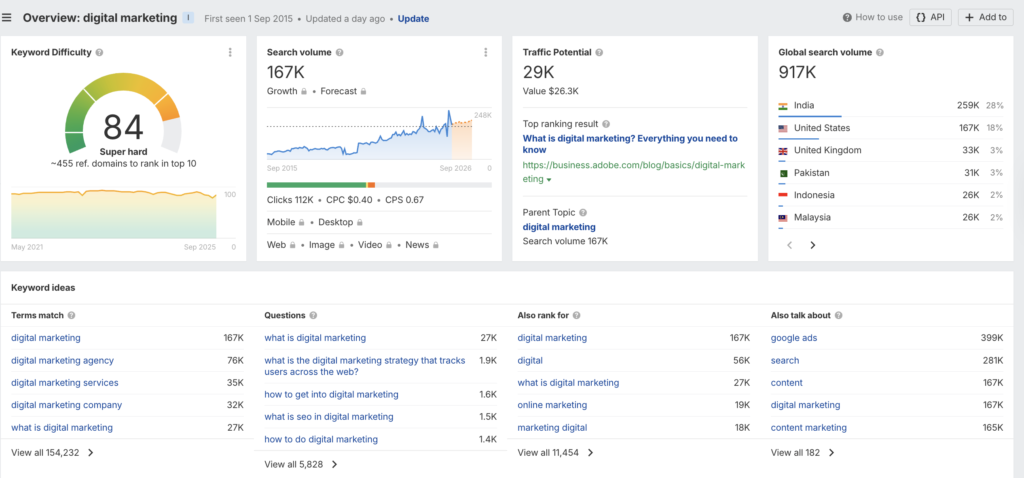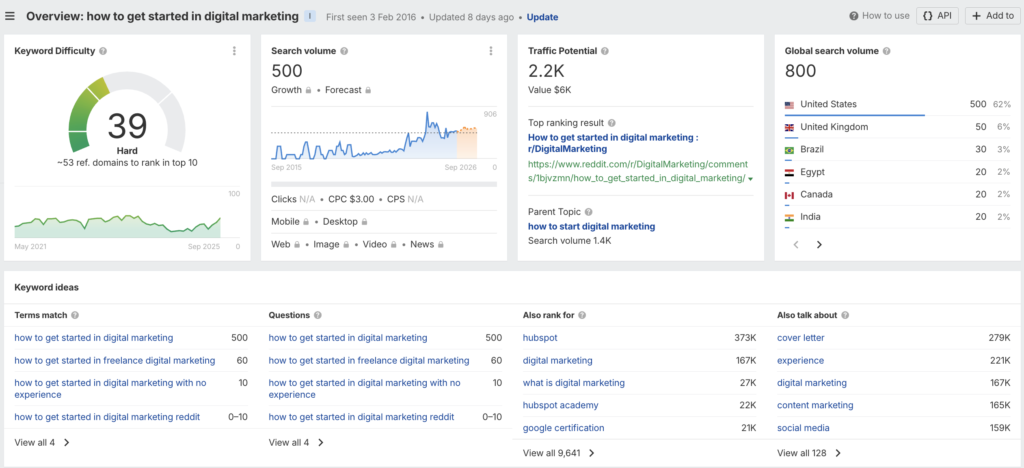Search engine optimization has never been static. Plus, 2025 is proving that point more than ever.
While trends come and go, the debate between long-tail and short-tail keywords continues to influence how marketers develop content marketing strategies.
When you work closely with SEO experts in Toronto, you will be able to understand the difference between these two keywords. In fact, the differences between these two types of keywords can either make or break a campaign.
Picking a keyword isn’t just about picking one. You need to understand how each keyword works in the modern-day search landscape and how it fits into a broader content strategy.
In this article, you will learn about how long and short-tail keywords are different from one another, how user behaviour is reshaping keyword relevance, and which of the two drives better results in 2025.
What is the Fundamental Difference Between Long-Tail and Short-Tail Keywords?
Before you can choose between long-tail vs short-tail keywords, it is important to understand how they are fundamentally different, not just in length, but in intent, competition, and conversational behaviour.
What are Short-Tail Keywords?
Short-tail keywords are broad, often one or two-word search terms, like “Digital Marketing,” “headphones,” or “fitness programs.”

Short-Tail Keyword Example
As they cover a wide topic area, they usually have:
- High search volume: Thousands or even millions of searches per month.
- Intense competition: Dozens of top websites are competing to rank the same term.
- Lower conversion rates: These keywords tend to attract general visitors who might still be in the awareness stage.
Ranking for short-tail keywords can drive significant traffic. However, traffic isn’t necessarily equal to conversions.
For example, someone searching “laptops” could be looking for reviews, specs, news, or just images, which makes it hard to align content directly to their intent.
What are Long-Tail Keywords?
These keywords are more specific. They usually contain three or more words, like “best budget noise-friendly headphones for travel,” or “how to build muscle after 40”, or “tiny house for sale South Carolina” – all specific queries that show clear buyer intent and are easier to rank for than broad terms like ‘headphones,’ ‘fitness,’ or ‘houses.’

Long-Tail Keyword Example
Long-tail keywords usually have the following things:
- Lower search volume: Fewer people search for them as compared to short-tail keywords.
- Less competition: Fewer websites target such keywords in a direct way.
- Higher conversion rates: They often attract users who know what they want and are closer to making a decision.
While long-tail keywords don’t pull a major amount of traffic, the visitors they do attract are often far more qualified, which implies a higher chance of turning them into leads and customers.
How Search Behaviour is Changing in 2025?
As mentioned earlier, it is important to understand the current behaviour of search users is extremely important when deciding you are deciding where to focus your keyword strategy.
As a matter of fact, search engines have become more sophisticated than ever, and users themselves have changed the way they search. Here’s how it has become so:
- Search Intent has Become More Highly Detailed
In previous times, people typed vague keywords into search engines and searched through results. Today, courtesy of voice search, mobile-first browsing, and AI-driven search features, users phrase their queries like they were asking a question to a person. This has resulted in conversational searches like:
- “What’s the safest electric car under $40000 in Canada?”
- “Best places to learn data analytics online for free”
- “How to fix blurry photos on an iPhone without an app”
These types of searches are naturally long-tail. They are driven by intent and specific, implying that search engines can match them more conveniently with content that is equally specific.
- Google’s Algorithm Rewards Relevance over Volume
As algorithm updates focus heavily on experience, expertise, authoritativeness, and trustworthiness(E-E-A-T), relevance has become a priority. Instead of rewarding content that simply uses popular keywords, search engines now rank pages that showcase depth, expertise, and a clear understanding of user intent.
Short-tail keywords might get your content seen by a wider audience, but if your page isn’t able to satisfy the intent of that audience, it won’t stay on top for long. Long-tail keywords naturally align better with user intent, making them more compatible with the current SEO landscape.
Pros and Cons of Short-Tail Keywords
Short-tail keywords are far from obsolete. However, they have both benefits and negatives in the current environment:
Pros:
- Ranking for short-tail terms can help you dramatically boost brand awareness thanks to their massive search volume.
- Even partial rankings or appearances in related search features can deliver substantial site traffic.
- They are ideal for introducing a new brand to a large audience, especially if they are paired with strong paid search campaigns.
Cons:
- Short-tail keywords are dominated by authoritative sites, which makes it difficult for smaller or newer brands to break through.
- Many users are only browsing, so even if they visit your site, they won’t be taking any action.
- It is more difficult to align content with such a broad keyword, which may result in lower engagement and higher bounce rates.
Short-tail keywords work the best when your goal is brand visibility or when you have a highly authoritative website. Otherwise, the cost and effort required to compete can be more than the benefits.
The Advantages and Disadvantages of Long-Tail Keywords in 2025:
Long-tail keywords have grown in strategic value over the last few years, especially with the rise of AI-driven search and voice assistants. Its pros and cons include:
Pros:
- People using long-tail keywords often know exactly what they are looking for. This further increases the potential of their conversion.
- It is easier to rank for long-tail keywords, which makes them more cost-effective.
- As your content directly answers a specific question, users tend to stay longer and interact more.
Cons:
- There won’t be huge spikes in traffic from a single long-tail keyword.
- You need multiple pieces of content targeting different long-tail keywords to achieve consistent traffic.
- It takes more upfront work to recognize the right long-tail keywords that align with the pain points of your audience.
Despite these drawbacks, the return on investment from long-tail keywords is often stronger, especially for businesses that are looking to attract qualified leads instead of just raw traffic.
How to Strategically Blend Both Long-Tail and Short-Tail Keywords?
The most effective SEO strategies in 2025 don’t rely on choosing between long-tail and short-tail keywords. In fact, they blend both to ensure maximum impact. Here’s what you can do for the same:
- Use Short-Tail for Awareness and Long-Tail for Conversions
A common mistake is thinking you must follow only one type of keyword. However, in reality, they can serve different purposes within your funnel. Short-tail keywords can introduce new visitors to your brand through top-of-funnel content like blog posts and landing pages.
Once those visitors engage with your brand, long-tail content can guide them down the funnel toward the conversion.
- Cluster Content Around Topics
Create pillar pages targeting broader short-tail keywords, then build a cluster of detailed long-tailed articles that link back to that pillar. Following this approach will lead to:
- Establishment of topical authority
- Improvement in internal linking for better SEO
- Coverage of user intent across every stage of the buying journey
For instance, a pillar page might target “digital marketing,” while the supporting cluster includes pages like “how to create a digital marketing strategy for small businesses,” “best free digital marketing tools in 2025,” and “how to track digital marketing ROI.”
- Monitor Search Trends and Intent Signals
Avoid guessing and let the data guide you. You should use tools that will help you track the keywords used by your audience in 2025, how their intent changes with time, and what kind of content gets the most engagement. As search behaviour keeps shifting, you need to revisit your keyword mix on a regular basis.
Why Long-Tail Keywords are Winning in 2025?
While both types have importance in their own right, long-term keywords are increasingly driving better outcomes, especially for small to mid-sized businesses. Here’s how it is able to do so:
- As voice search assistants and AI search become standard, people are naturally asking longer and more specific questions.
- Search engines now expect content to be personalized to a user’s unique context. Long-tail keywords allow you to create that personalized experience.
- By focusing on specific, in-depth topics, your content now showcases expertise and trustworthiness. These are the two elements prioritized heavily by search engines.
In simple terms, long-tail keywords are more in tune with how people search today. They may not bring overnight traffic explosions, but they help you build sustainable and high-converting organic visibility over time.
Furthermore, you need to:
- Focus on questions and problems.
- Optimize for search intent, not just volume.
- Track engagement, not just rankings.
- Refresh and expand older content.
To Summarize
Having both long-tail and short-tail keywords is extremely important for SEO. Shorter ones can boost brand reach, but long-tail keywords are far better at driving meaningful, conversion-ready traffic in 2025.
The best approach you can do is to combine both of them in a strategic way. This means you need to use short-tail keywords to capture attention, and long-tail keywords to capture intent.









